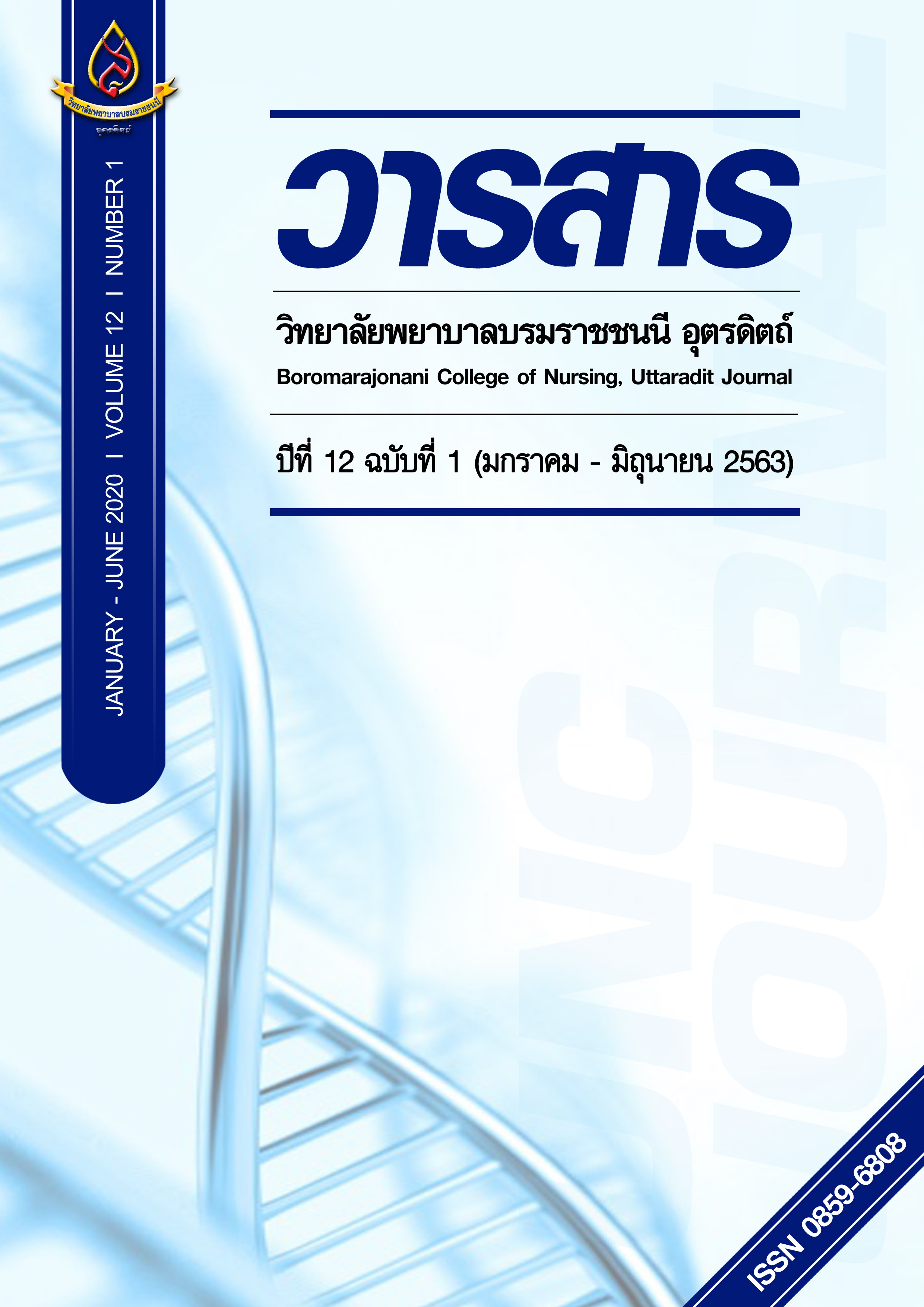การเสริมสร้างความรอบรู้ด้านสุขภาพในผู้ป่วยเบาหวานชนิดที่ 2
Main Article Content
บทคัดย่อ
ผู้ป่วยเบาหวานชนิดที่ 2 มีความเสี่ยงภาวะแทรกซ้อนด้านสุขภาพ ทั้งโรคหัวใจ โรคหลอดเลือดสมอง จอประสาทตาเสื่อมจากโรคเบาหวาน การถูกตัดขา และการเสื่อมของหลอดเลือดที่ไตจากเบาหวาน เป็นต้น เป้าประสงค์ของการรักษาโรคเบาหวานคือ การควบคุมระดับน้ำตาลให้เป็นปกติและการลดปัจจัยเสี่ยงด้วยการให้ยาและปรับเปลี่ยนพฤติกรรมเพื่อลดปัจจัยเสี่ยงดังกล่าว ความรอบรู้ด้านสุขภาพในผู้ป่วยเบาหวานชนิดที่ 2 คือการที่บุคคลได้รับข้อมูลทางสุขภาพ การสื่อสารข้อมูลสุขภาพ เข้าใจในข้อมูลเกี่ยวกับโรคเบาหวาน เข้าใจกระบวนการดูแลตนเอง อันนำไปสู่การตัดสินใจในการดูแลสุขภาพ ดังนั้น ผู้ป่วยเบาหวานชนิดที่ 2 ที่มีความรอบรู้ด้านสุขภาพที่เหมาะสม จะสามารถปฏิบัติกิจกรรมที่ดูแลสุขภาพของตนเองได้ บทความนี้ มีวัตถุประสงค์เพื่ออธิบาย ความหมายและหลักการรักษาโรคเบาหวานชนิดที่ 2 ความหมายของความรอบรู้ด้านสุขภาพ ความสำคัญของความรอบรู้ด้านสุขภาพในโรคเรื้อรัง ความเกี่ยวข้องระหว่างความรอบรู้ด้านสุขภาพกับผลลัพธ์ทางสุขภาพในผู้ป่วยเบาหวานชนิดที่ 2 และการพัฒนากระบวนการดำเนินการที่มีประสิทธิผลในการเสริมสร้างความรอบรู้ด้านสุขภาพในผู้ป่วยเบาหวานชนิดที่ 2 อันจะนำไปสู่การมีผลลัพธ์ทางสุขภาพที่ดีในผู้ป่วยเบาหวานชนิดที่ 2 ต่อไป
Article Details
บทความหรือข้อคิดเห็นใดใดที่ปรากฏในวารสารวิจัยการพยาบาลและวิทยาศาสตร์สุขภาพ เป็นวรรณกรรมของผู้เขียน ซึ่งบรรณาธิการหรือสมาคมศิษย์เก่า ไม่จำเป็นต้องเห็นด้วย และบทความที่ได้รับการตีพิมพ์เผยแพร่ถือเป็นลิขสิทธิ์ของวารสารวิจัยการพยาบาลและวิทยาศาสตร์สุขภาพ
เอกสารอ้างอิง
Aekplakorn, W. (Ed.). (2014). Thai health examination by the 5th physical examination in 2014. Nonthaburi: Institute of Health Systems Research. (in Thai).
American Diabetes Association. (2018). Standard of medical care in diabetes-2018. Diabetes Care, 41(Supplement 1), S144-S151.
Bailey, S. C., Brega, A. G., Crutchfield, T. M., Elasy, T., Herr, H., Kaphingst, K.,…Schillinger, D. (2014). Update on Health Literacy and Diabetes. Diabetes Education, 40(5), 581– 604.
Berkman N. D., Sheridan S. L., Donahue K. E, Halpern D.J., & Crotty K. (2011). Low healthliteracy and health outcomes: an updated systematic review. Annals of InternalMedicine, 155(2), 97–107. doi: 10.7326/0003-4819-155-2-201107190-00005
Berkman N., Terry D., & McCormack L. (2010). Health literacy: What is it?. Journal Health Community,15(Suppl 2), 9–19. doi: 10.1080/10810730.2010.499985.
Cavanaugh, K., Wallston, K.A., Gebretsadik, T., Shintani, A., Huizinga, M.M., Davis, D.,…Rothman, R.L. (2009). Addressing literacy and numeracy to improve diabetes care: two randomized controlled trials. Diabetes Care, 32(12), 2149–2155. doi: 10.2337/dc09-0563.
Chantha, W. (2016). Effects of patient empowerment on self-efficacy, adherence and glycemic control in patients with type 2 diabetes. (Master’s thesis). Thammasat University, Bangkok. (in Thai).
DeWalt, D.A., Davis, T.C., Wallace, A.S., Seligman, H.K., Bryant-Shilliday, B., Arnold, C.L.,… Schillinger, D. (2009). Goal setting in diabetes self-management: taking the baby steps to success. Patient Education and Counseling, 77(2), 218–223. doi: 10.1016/j.pec.2009.03.012.
Health Education Division, Department of Health Services Ministry of Public Health. (2018). Strengthening and assessing health literacy and health behavior children and youth groups aged 7-14 years and people aged 15 years and over Revised Edition BE 2561. Retrieved (2019, January 11) from http://www.hed.go.th/linkHed/364 (in Thai).
International Diabetes Federation. (2017). IDF diabetes atlas 8th edition: Keymessage. Retrieved (2017, September 18). from http://www.diabetesatlas.org/key-messages.html
Kaedumkoeng K. (2018). Health Literacy: acess, understand, and application. 2nd Bangkok: Amarin Printing & Publishing Public Company Limited. (in Thai).
Kandula, N.R., Nsiah-Kumi, P.A., Makoul, G., Sager, J., Zei, C.P., Glass, S.,…Baker, D.W. (2009). The relationship between health literacy and knowledge improvement after a multimedia type 2 diabetes education program. Patient Education and Counseling, 75(3), 321–327, Retrieved (2018, January 18) from https://doi.org/10.1016/j.pec.2009.04.001
Matsee, C., & Waratwichit, C. (2017). Promotion of health literacy: from concept to practice.Boromarajonani College of Nursing, Uttaradit Journal, 9(1), 96-111. (in Thai)
Muangkum, A., & Suttajit, S. (2013). Effects of patient empowerment on self-efficacy, adherence and glycemic control in patients with type 2 diabetes. Thai Pharmaceutical and Health Science Journal, 8(3), 104-111. (in Thai).
Ntiri, D., & Stewart, M. (2009). Transformative learning intervention: effect on functional health literacy and diabetes knowledge in older African adult. Gerontology & Geriatrics Education, 30(2), 100-113. doi: 10.1080/02701960902911265
Nutbeam, D. (2000). Health Literacy as a public health goal: a challenge for contemporary health education and communication strategies into health 21st century. Health Promotion International, 15(3), 259-267.
Nutbeam, D. (2008). Health literacy and adolescents: a framework and agenda for future research. HeaIth Education Research, 23(5), 840–847. doi: 10.1093/her/cym069
Osborn, C. Y., Cavanaugh, K., Wallston, K. & Rothman, R. L. (2010). Self-Efficacy links health literacy and numeracy to glycemic control. Journal of Health Communication, 5(Suppl 2), 146–158. doi:10.1080/10810730.2010.499980
Panyasai, K., Phucharoen, P., & Piayoo, N. (2017). Evaluation of Health Promotion for Peopleat Risk of Diabetes Mellitus and Hypertension. Journal of Phrapokklao Nursing College,28(1), 51-62. (in Thai).
Powers, M A. Bardsley, J., Cypress, M., Duker, P., Funnell, M. M., Fischl, A. H.,…Vivian, E. (2015). Diabetes self-management education and support in type 2 diabetes: a joint position statement of the American diabetes association, the American association of diabetes educators, and the academy of nutrition and dietetics. Journal of Academy of Nutrition and Dietetics, 115(8), 1323–1334. doi: 10.1016/j.jand.2015.05.012
Pannark, P., Moolsart, S., & Kaewprom, C. (2017). The effectiveness of a program for health literacy development of the patients with uncontrolled type 2 diabetes at Bangwua District, Chachoengsao province. Nursing Journal of the Ministry of Public Health, 27(3), 91-106. (in Thai).
Sabysook, N., Supametaporn, P., & Songthai, N. (2018). Relationship between risk perceptions, health behavior self-management and blood sugar level among diabetic high risk population in Muang, Lampang Province. Boromarajonani College of Nursing, Uttaradit Journal, 9(Supplement Issue), 137-150. (in Thai).
Schillinger, D., Grumbach, K., Piette, J., Wang, F., Osmond, D., Daher, C.,…Bindman, A.B. (2002). Association of health literacy with diabetes outcomes. The Journal of the American Medical Association, 288(4), 475–482.
Schillinger, D., Handley, M., Wang, F., Hammer, H. (2009). Effects of self-management support on structure, process, and outcomes among vulnerable patients with diabetes. Diabetes Care, 32(4), 559–566.doi: 10.2337/dc08-0787.
Strategy and Planning Division Ministry of Public Health. (2017). Statistical Thailand 2017. Retrieved (2018,March 19) from http://bps.moph.go.th/new_bps/sites/default/files/ health%20stratistic%202560.pdf (in Thai).
Taegmuang, J., & Muktabhant, B. (2018). Associated between health literacy and self-care of type 2 diabetic patients. Journal of Health Education, 41(1), 103-113. (in Thai).
Van Scoyoc, E. E., & DeWalt, D. A., (2010). Intervention to Improve Diabetes Outcome for People with Low Literacy and Numeracy: A systematic Literature Review. Diabetes Spectrum, 23(4), 228- 237. Retrieved (2018, September 18) from https://doi.org/10.2337/ diaspect.23.4.228
Wallace, A.S., Seligman, H.K., Davis, T.C., Schillinger, D., Arnold, C.L., Bryant-Shilliday, B.,…DeWalt, D.A. (2009). Literacy appropriate educational materials and brief counseling improve diabetes self- management. Patient Education and Counseling, 75(3), 328–333, doi: 10.1016/j.pec.2008. 12.017.
White, R. O., Wolff, K., Cavanaugh, K. L., & Rothman, R. (2010). Addressing health literacy and numeracy to improve diabetes education and care. Diabetes Spectrum, 23(4), 238-243. doi.org/10.2337/diaspect.23.4.238.
World Health Organization [WHO]. (2016). Global Report on Diabetes. Retrieved (2018, March 19) from
http://appswho.int/iris/bitstream/handle/10665/204871/9789241565257_eng.pdf;jsessi onid=B4B8381EEA800DAA435517ED043675A9?sequence=1


